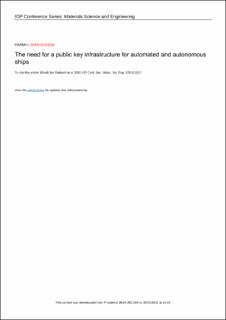| dc.contributor.author | Rødseth, Ørnulf Jan | |
| dc.contributor.author | Frøystad, Christian | |
| dc.contributor.author | Meland, Per Håkon | |
| dc.contributor.author | Bernsmed, Karin | |
| dc.contributor.author | Nesheim, Dag Atle | |
| dc.date.accessioned | 2023-05-09T10:33:03Z | |
| dc.date.available | 2023-05-09T10:33:03Z | |
| dc.date.created | 2020-12-15T17:36:37Z | |
| dc.date.issued | 2020 | |
| dc.identifier.citation | IOP Conference Series: Materials Science and Engineering. 2020, 929, 012017. | en_US |
| dc.identifier.issn | 1757-8981 | |
| dc.identifier.uri | https://hdl.handle.net/11250/3067243 | |
| dc.description.abstract | Shipping undergoes rapid digitization, covering safety and security reporting, mandatory ship documentation, electronic port clearance as well as commercial and operational information exchanges. Increasing automation of information processing, including the specific needs for autonomous ships, requires increased "digital trust" to allow humans to remove themselves from the information processing loops. This includes better safeguards against cyber threats such as counterfeiting contents or the originator of critical messages. This paper describes thirteen use cases for maritime services and analyse how a Public Key Infrastructure (PKI) system can provide security barriers to mitigate relevant cyber threats and possible consequences of unwanted events. Such a PKI needs to be designed with the special maritime business constrains in mind; the most important being the international nature of shipping, the lack of connectivity for ships that are far from shore, the network constraints associated with existing communication technologies and regulatory considerations. | en_US |
| dc.language.iso | eng | en_US |
| dc.publisher | IOP | en_US |
| dc.relation.uri | https://iopscience.iop.org/article/10.1088/1757-899X/929/1/012017/pdf | |
| dc.rights | Navngivelse 4.0 Internasjonal | * |
| dc.rights.uri | http://creativecommons.org/licenses/by/4.0/deed.no | * |
| dc.title | The need for a public key infrastructure for automated and autonomous ships | en_US |
| dc.type | Peer reviewed | en_US |
| dc.type | Journal article | en_US |
| dc.description.version | publishedVersion | en_US |
| dc.rights.holder | © The authors 2020. Published under licence by IOP Publishing Ltd. | en_US |
| dc.source.pagenumber | 12 | en_US |
| dc.source.volume | 929 | en_US |
| dc.source.journal | IOP Conference Series: Materials Science and Engineering | en_US |
| dc.identifier.doi | 10.1088/1757-899X/929/1/012017 | |
| dc.identifier.cristin | 1860225 | |
| dc.relation.project | Norges forskningsråd: 295969 | en_US |
| dc.relation.project | EC/H2020/815012 | en_US |
| dc.source.articlenumber | 012017 | en_US |
| cristin.ispublished | true | |
| cristin.fulltext | original | |
| cristin.qualitycode | 1 | |

